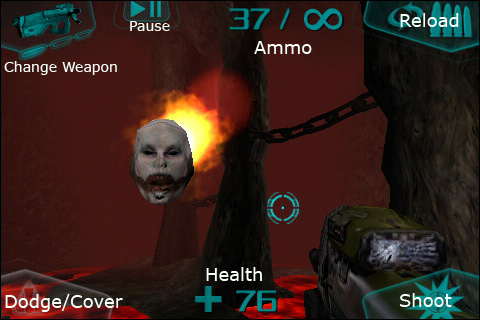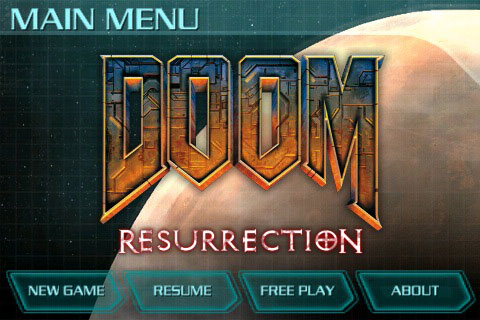Doom Resurrection – Mechanics Analysis
November 24th, 2010
You could probably sort my iPod app store purchases into a few core groups: platform-specific games with a strong reputation (Spider, Space Invaders: Infinity Gene, Rolando, Eliss), games made popular on other platforms which are cheaper and run well on the iPod (Ace Attorney, Cooking Mama, Diner Dash, Mr Driller) and games which are iPod exclusive instalments of major game franchises (Assassins Creed 2, Doom RPG, Wolfenstien RPG). As you might have guessed Doom Resurrection belongs in the last camp.
Resurrection is one of those games that attempts to push the technology of a portable platform beyond what is usually expected of it, and while Epic’s Infinity Blade kinda makes it seem redundant now, it doesn’t hinder the fetish that I have for these types of progressive portable games. Whether the design can match the technical prowess, we’ll see—but for now, here’s a trailer.
Overview
Doom Resurrection is an on-rails shooter using scaled-down assets from Doom III. Movement is automated, leaving the player to deal with hell’s minions. There are no branching paths. Resurrection is completely linear. There are a total of 8 levels in the main single player mode, a challenge mode with a variety of set objectives to complete and a maps mode which has an additional map (maybe they were planning more DLC maps?). On completing a level the player is given an alphabetic rank. The interface is as labelled.
Primary mechanics
Aiming
Aiming is done by tilting the device and feels surprisingly natural. There are 3 sensitivity settings and all feel very comfortable to play around with. The fact that you’re tilting the same screen that you’re focusing on is inherently problematic, but this is just a common design issue with the device. I honestly don’t think that there’s much that could be done to remedy this. Touching the individual enemies to shoot is an alternative, but that would obscure the view even more than a tilted screen or glare.
The reticle is calibrated at the start of each level and can be recalibrated easily by pausing the game, moving the device into a comfortable position and tapping the calibration option which resumes play and recalibrates the device.
Shooting
Shooting is as simple as tapping a button in the bottom right corner. There’s no external factors that affect the shooting.
Secondary Mechanics
Reload
Item Pick Up
Health packs and munition can be picked up off the ground by tapping them. I mentioned just before that this could obscure the player’s view if used for shooting, the same is true for picking up items. The developers cleverly avoid this issue though by sequencing item dumps in-between instances of shooting so that the player is never in danger when they might be blocking their own view. This sequencing helps to break up the straight sections of shooting as well.
Occasionally, item drops will be backgrounded on-screen during enemy confrontations. In these sequences, it’s up to the player to listen out for enemy cries which indicate arriving swarms. By following the rhythm of arriving monsters, the player can spot moments of downtime and nab the floating goodies at their most opportune. Otherwise, trying to grab items while foes are around will effectively offer them a few free pot shots.
Each instance of shooting has an allotted quota of time before, once the player has cleared the screen, either the next set of ghouls come forward or the game progresses to the next instance. The longer the player takes to down the monster, the more they cut into this time frame to grab items. In this case, these item incentivise fast and accurate shooting. My description supposes that this was a conscious design decision, however I’m doubtful, because if it were then it would have been more effective to replace the standard ammo and health packs with the “hidden secret” items which, to semi-subversion of my argument, are ammo and health pack hidden in breakable boxes. The difference being that they add to the player’s rank at the end of the stage—displayed on the tally of conditions.
Actually, using the pre-existing “hidden secrets” is a bit of a waste as well. Changing them out for something like special tokens that act as currency for unlocking additional maps or bonus goodies would give the player much more incentive to get the maximum use out of the play mechanics. And anyways, the “hidden secrets” are hardly a secret given that they’re in every breakable box in the game.
Dodging
Enemies which look a bit like re-deads from Zelda (along with some bosses) throw fireballs at the player which they can dodge by tapping the “dodge” button in the bottom left. This move can also be used to avoid physical attacks too. The implementation of this mechanic is a little clumsy.
What throws me about dodging is that the quickness of the dodge makes it very immediate, drawing the player in and out of the action for a brief moment. This breaks the player’s sense of where their cursor’s located due to the way the way they physically re-orientate the device during these moments of confusion as the viewpoint shifts. So when the screen does return to its original position, the player must re-adjust their reticle quickly so that they can kill the re-dead look-a-likes before they toss another fireball.
In the later levels, Resurrection throws more than one of these enemies on screen at once, sometimes they even add zombies and other player-approaching nasties. As you can imagine, these moments are a literal mess as the player must re-orientate their reticle while other enemies are either walking towards them or scratching their face off.
At least the nature of this mechanic creates a strategic dynamic. Even if that strategy is to simply clear the most annoying monsters first.
Cover
Roughly a fifth of all shoot-outs involve taking cover against grunts. The on-screen button for covering is the same as dodge, so, seemingly as not to confuse players, the stages tend to privilege one mechanic or the other.
The main difference between the two is that the player holds their position while in cover and the cover button must be pressed to draw the player back out into the open. Yellow circle indicators support the cover mechanic by informing the player when the enemy has cleared their clip (the indicator shrinks as their ammo decreases and turns red once they’ve spent the clip). Initially the grunts reload in plain sight, but later they will jump into cover themselves. There’s never anymore than 2 grunts populating these instances of play. These shoot-outs require the player to follow the indicators so as to find the right intervals of time to pop out and gun down the enemies. Of course, reloading needs to be factored in too.
These confrontations become formulaic when used for the duration of an entire level (for which they generally are and then not used again for entirely too long) and are particularly drawn out in the Alpha Labs level near the end of the game. The only way these sequences can be more difficult is if the time intervals where neither of the 2 grunts are shooting (and are just standing around) is made increasingly more narrow by way of overlap (one enemy shoots, while the other is reloading in cover and vica-versa), while the airtime for to clear clips is longer. The consequence of this is that as the enemies are given more time to dispense their clips, the player is still waiting in cover, creating large amounts of dead space in the gameplay. This (being alpha labs) eventually amounts to the player only being able to land hits on enemies quickly returning to cover; a really scabby way to play if you ask me.
Shake
Granted my criticisms above of the dodge and cover mechanic, the shake mechanic is the worst of all 3 for throwing off the players view as, ironically, this mechanic actually requires the player to throw off their own view.







 Game Design Companion: A Critical Analysis of Wario Land 4 - $7.99
Game Design Companion: A Critical Analysis of Wario Land 4 - $7.99 Level Design: Processes and Experiences
Level Design: Processes and Experiences Speed Boost: The Hidden Secrets Behind Arcade Racing Design - $5.99
Speed Boost: The Hidden Secrets Behind Arcade Racing Design - $5.99 Adventures in Games Analysis: Volume I - $5.99
Adventures in Games Analysis: Volume I - $5.99







